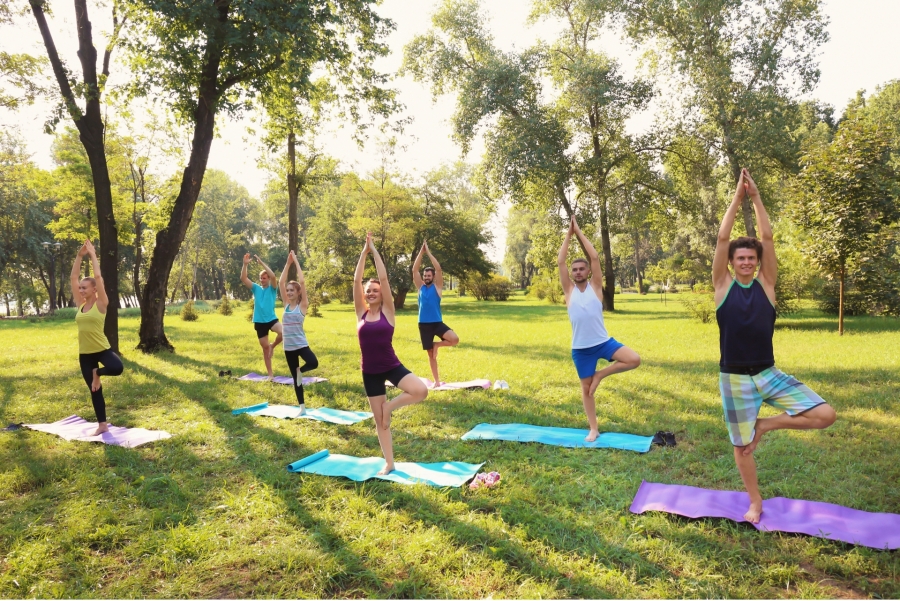The fitness industry is a vibrant and ever-evolving domain that encompasses a wide range of activities, products, and services aimed at promoting physical well-being and healthy lifestyles. It is pivotal in meeting the growing global demand for improved health and fitness.
This post covers industry trends, demographic shifts, and how large operators can leverage these insights to drive growth.
Key Statistics Driving the Fitness Industry in 2024
Global Fitness Industry Overview
The global fitness industry has proven its resilience, with significant recovery post-pandemic. In 2022, the global market was valued at $104.05 billion and is projected to reach $202.78 billion by 2030, reflecting a robust compound annual growth rate (CAGR) of 8.4%. The push toward healthier lifestyles, coupled with advances in technology, has enabled the sector to evolve in exciting ways.
- Emerging Markets: The Asia Pacific region (APAC) is projected to experience the highest growth rate (CAGR of 8.1%) in the fitness equipment market by 2030. This statistic emphasises the immense potential of the Asia Pacific within the fitness equipment market. (DataBridge)
- Global Pilates & yoga studios market is expected to grow at a CAGR of 10% from 2021 to 2028. This statistic is a testament to the increasing popularity of Pilates and yoga studios worldwide, indicating that the global fitness industry is on the rise. (ResearchDive)
European Fitness Market Insights
Europe has solidified its position as one of the world’s leading fitness markets. According to the European Health & Fitness Market Report, European memberships increased by 4.7 million (+7.5%), rising from 62.9 million in 2022 to 67.6 million by year-end 2023, exceeding figuresfrom the last pre-pandemic year of 2019.
Total European revenues saw a robust growth of +14%, reaching €31.8 billion in 2023, again surpassing the previous 2019 record. The number of fitness clubs also saw modest growth, rising by +1.4% to nearly 65,000 facilities across Europe.
In terms of market leaders, the top three fitness operators by membership remain unchanged from the previous year:
- Basic-Fit (3.8 million members)
- RSG Group (2.0 million members)
- Pure Gym (1.9 million members)
When looking at revenue, the top three were:
- Basic-Fit (€1,047 million)
- David Lloyd (€854 million)
- Pure Gym (€621 million)
The 20 largest operators in Europe saw notable growth, with their combined memberships increasing by almost 2 million (+13%) to 17.4 million. Their revenues grew to €6.2 billion (+19%).
Additionally, 12 major mergers and acquisitions (M&A) were completed in 2023, underscoring the continued investor confidence in traditional brick-and-mortar fitness businesses. These transactions reflect the ongoing centrality of gym operators in the industry’s ecosystem, even amid the rise of digital fitness solutions.
Fitness club membership penetration also increased, rising to 8.4% of the total population (up from 7.9% in 2022) and 10.1% of the 15+ population (up from 9.5% in 2022). These numbers highlight the significant growth potential that still exists for the sector across Europe.
According to Deloitte, gyms in Europe operate an average of 116 hours per week, with staff present 84% of the time. The remaining time is typically covered by fully automated systems, which operate for an average of 2.6 hours daily.
UK Fitness Sector
The UK fitness industry has experienced steady growth over the past five years, with a compound annual growth rate (CAGR) of 1.7%, bringing total industry revenue to an estimated £2.8 billion by 2024. It comprises 5,500 businesses and employs nearly 50,000 people across the entire United Kingdom.
The leading companies in the UK gym and fitness sector by projected 2025 revenue are:
- David Lloyd Leisure Ltd: £687.2 million
- Pure Gym Ltd: £396.3 million
- Nuffield Health: £354.4 million
Germany Fitness Sector
The German fitness industry has faced a downturn over the past five years, with industry revenue declining at a compound annual growth rate (CAGR) of 3.3%, reaching an estimated €4.9 billion by 2024.
The largest gym companies by projected 2024 revenue are:
- RSG Group GmbH: €250.8 million
- Clever Fit GmbH: €248.6 million
- Kieser Training AG: €188.6 million
The industry consists of 7,212 businesses and employs approximately 88,000 people.
According to Deloitte, the German fitness industry serves 11.3 million members across 9,111 clubs, highlighting the significant size of the market despite recent revenue challenges.
Trends and Insights:
- The German fitness industry is witnessing a diversification of services. Micro studios crater to niche markets, while large fitness chains are increasingly evolving into full-service providers.
- Fitness centres are target the older population, particularly those aged 65 and over, representing a growing segment with significant sales potential.
- The distribution of fitness centres mirrors population density, with the Mitte and Süd regions boasting the highest concentration of establishments due to their large populations.
- Although the industry is still largely composed of smaller independent studios, major fitness chains have pursued aggressive expansion strategies in recent years, gradually capturing market share from individual studios.
US Fitness Market
The US gym and fitness industry comprised 90,656 businesses as of 2023, marking a -2.1% decline from 2022. The states with the highest number of gym and fitness businesses are:
- California: 15,271 businesses
- Florida: 9,155 businesses
- New York: 8,916 businesses
The total market size of the US fitness industry was valued at $40.6 billion in 2023. This represents a -5.1% decrease compared to 2022, with an annual average decline of 1.5% between 2018 and 2023. The industry faces challenges from high competition and low barriers to entry, which are the primary negative factors impacting growth.
In terms of employment, the industry had 644,450 employees in 2023, down -4.9% annually on average over the past five years. The average gym in the US has 6.6 employees.
Canada Fitness Sector
The Canadian gym and fitness industry has experienced a decline at a CAGR of 3.8% over the last five years, with projected 2024 revenue reaching $4.5 billion.
The largest fitness companies by 2024 projected revenue are:
- GoodLife Fitness Centres Inc.: $1,027.6 million
- LA Fitness International LLC: $93.6 million
- PFIP LLC: $32.8 million
Trends and Insights:
- Memberships have declined in Canada, driven by time and financial constraints for consumers. Falling consumer confidence, exacerbated by the COVID-19 pandemic and ongoing inflation, has resulted in many consumers cutting back on gym memberships to reduce discretionary spending.
Australia Fitness Sector
The Australian fitness industry has faced a 2.0% annual decline over the past five years, with an estimated 2024 revenue of $2.9 billion.
The largest fitness companies by projected 2025 revenue are:
- Fitness and Lifestyle Group: $699.4 million
- Anytime Fitness: $601.3 million
- Viva Leisure: $272.8 million
Trends and Insights:
- Post-pandemic, membership numbers have surged, following the significant losses during the COVID-19 lockdowns. With gyms and fitness centres deemed non-essential during the pandemic, government-enforced closures resulted in a steep drop in revenue and memberships, which have since begun to recover.
Insights on Fitness Club Members and Engagement in Sports
- Among customers who generally practice fitness: 19% exclusively do club-based exercise, 22% exclusively exercise at home (during COVID-19 28%), 15% exclusively exercise outdoor, 8% combine all three, 6% exercise at home and a club.
- Barriers to exercise: 26% of people without a regular fitness routine say they don’t enjoy fitness, 21% face motivational challenges, and 17% cite time constraints.
- Regular fitness practitioners spend an average of 5.6 hours per week on their fitness routines.
- Home workout trends: 30% exercise 1–2 times a week, 37% 3–4 times, and 31% more often. Almost 60% do so without guidance, while 33% prefer online on-demand content.
- Fitness club attendance: 43% attend clubs 1–2 times per week, 40% 3–4 times, and 17% less frequently. Two-thirds of fitness club users are Millennials or Gen Z.
- Club selection criteria: Price, value for money, and quality of equipment are the most important factors when choosing a fitness club.
- Challenges with fitness clubs include the fact that 49% of non-club users prefer working out alone, 38% dislike being restricted by opening hours, 23% find the club atmosphere unmotivating, and 43% express a preference for fully automated, staff-free environments.
Other insights:
- Reasons for joining a fitness club, according to UK Active & Savanta, include improving or maintaining physical strength and fitness (82%), enhancing mental health and well-being, including managing anxiety or depression (79%), boosting overall confidence and appearance (75%), and improving sleep quality (67%).
- Norway and Sweden lead with 22% of their populations regularly attending gyms, followed by the US at 21.20%. (Helsinki Times)
- Amsterdam has been crowned the world's fittest city. The city boasts the highest number of individuals who cycle to work, at nearly 46%, and many gym fanatics, nearly 17.5% of the population. (Helsinki Times)
- In the UK, 49% of women participate in sports or physical activity, with younger generations (18-24 years old) showing greater engagement. Females dominate in endurance sports (39% of runners, 36% of cyclists) and wellness activities like yoga, HIIT classes, and Pilates (64%). (Ernst & Young)
- According to the 2022 IHRSA Global Report, women constitute a larger share of gym membership in most regions, accounting for approximately 57% of gym-goers globally.
- Millennials, often referred to as the “wellness generation,” view health as a top priority. This group is particularly drawn to boutique fitness studios and wellness-related technology, such as wearables. (Sanford)
Membership Trends and Insights
- 12% of new gym memberships are registered in January, making it the most crucial month for attracting new members. However, 50% of new members drop out within six months of joining. (IHRSA)
- Positive onboarding is key to retention: 87% of members who experience a positive onboarding process remain active after six months. (IHRSA)
- Why do members stay? 50% continue their gym membership because they like the location. 45% stay due to positive interactions with staff, and 38% stay because they like the equipment. (IHRSA)
Digitalisation and Fitness Technology
- Millennials are the most active users of fitness apps, with women using them twice as much as men. 46% want as much quantifiable data as possible about their health, and 54% are likely to purchase body-analysing devices. (Statista)
- In 2024, 9.76% of people globally are using fitness apps. This is expected to grow to 12.2% by 2027. (Statista)
- The fitness app market is valued at $22 billion in 2024, growing at an annual rate of 14.3%. The fitness app with the most downloads as of 2022 is Planet Fitness. (Mordor Intelligence)
- The demand for on-demand video fitness classes skyrocketed, with 311% growth post-COVID.
How Fitness Chains Can Leverage This Data?
Embrace Hybrid Models
Given that many people now exercise at home or outdoors, consider offering hybrid memberships that combine in-club access with virtual and outdoor fitness classes. By adding on-demand content, you'll cater to the 33% of home exercisers who prefer guided online sessions.
Automate and Personalise
If 43% of gym-goers want fully automated experiences, adopt AI-powered check-ins, automated workout plans, and wearables integration. This will offer your members a seamless, personalised experience while helping you reduce staff costs and increase engagement.
Target Millennials and Gen Z
Since Millennials and Gen Z make up a large proportion of gym-goers, focus on what matters to them: value for money, quality equipment, and mental health benefits. Highlight these in your marketing and offer programs like meditation or yoga to keep them engaged.
Attract the Female Market
If women are a significant portion of your members, expand your studio-based classes (e.g., yoga, Pilates, dance) and offer wellness services like spas or recovery areas. With women also using fitness apps more than men, consider creating female-specific digital content and in-app health insights to boost their engagement.
Focus on Affordability and Flexibility
Price and flexibility remain key decision factors for many gym-goers. Fitness chains should consider offering tiered pricing or pay-per-session models to attract those seeking flexible membership options. Additionally, flexible opening hours or 24/7 access could appeal to the 38% of members who dislike being bound by strict schedules. This strategy would make the gym more accessible to time-strapped or non-traditional members.
Improve User Experience and Engagement
To attract more members, introduce tiered pricing options or pay-per-session models for those who want flexibility. 24/7 access can also appeal to the 38% who dislike following fixed schedules, making your gym more accessible to a wider audience.
Capitalise on the January Surge
With retention starting from day one, focus on creating an excellent onboarding experience to keep new members engaged. Offering goal-setting sessions or assigning personal trainers early on can help members feel motivated, reducing the chances of churn. Additionally, build a sense of community through group classes, fitness challenges, or referral programs to strengthen loyalty and keep your members active.
From Crisis to Innovation: Impact Of COVID-19 On The Fitness Industry
The COVID-19 pandemic had a profound impact on the fitness industry, disrupting operations, challenging business models, and transforming the way people engage with fitness and wellness activities. As governments implemented strict measures to control the spread of the virus, gym closures, social distancing guidelines, and restrictions on indoor activities significantly impacted the traditional fitness landscape.
Closures and Financial Challenges
Gym closures and the temporary cessation of in-person fitness classes and services were among the most notable consequences of the pandemic. The shutdowns disrupted the revenue streams of fitness establishments, leading to financial challenges for many small and independent fitness businesses. According to IHRSA, the impact on the industry includes 1.5 million jobs lost until December 2021, 20.4 billion dollars in lost revenue, and 25% of fitness clubs and studios closed in the same period.
Swift Digital Adaptation
The COVID-19 pandemic acted as a catalyst for the industry's digital transformation, as lockdowns and social distancing measures compelled fitness enthusiasts to seek alternative ways to stay active and engaged with their fitness routines. To adapt to the challenging circumstances, fitness businesses swiftly embraced digital solutions. Virtual fitness classes and online training platforms became the new norm, allowing fitness enthusiasts to continue their workouts from the safety of their homes. This digital transformation helped many fitness businesses stay afloat and retain their client base during the pandemic. According to Statista, the number of health and fitness app downloads globally increased by 46% in the first half of 2020.
Rise of Hybrid Models
The pandemic also accelerated the adoption of hybrid fitness models, where fitness centres and studios offered a combination of in-person and virtual services. This hybrid approach allowed businesses to cater to local clientele and a wider, geographically diverse audience. The increased reliance on technology and virtual platforms may have long-term implications for the industry, as it has expanded access to fitness services beyond traditional brick-and-mortar establishments.
Surge in Outdoor Fitness Activities
Social distancing measures and health concerns led to a surge in outdoor fitness activities. People turned to outdoor workouts, such as running, cycling, and outdoor group fitness classes, to maintain physical fitness while adhering to safety guidelines. The pandemic highlighted the importance of outdoor spaces and their potential for fitness and well-being activities.
Top 10 Trends In The Fitness Industry In 2024
The fitness industry is driven by emerging trends shaping how people engage with fitness and wellness. In this section, we will explore the latest trends sourced from leading fitness authorities and discuss the future trends that will likely influence its trajectory.
1. Wearable Technology: Wearable devices, such as fitness trackers and smartwatches, have become increasingly prevalent in the fitness industry. These devices enable individuals to monitor their physical activity, track metrics like heart rate and calorie expenditure, and set goals for their fitness journey. Wearable technology has long been the top global trend since it was added to the 2016 survey, save for 2018 when it was #3 and 2021 (#2).
2. Strength Training With Free Weights: Free weight strength training focuses on improving or maintaining muscular fitness using barbells, dumbbells, kettlebells, and other equipment. In terms of popularity, training with free weights ranked #4 in 2020, dropped to #8 in 2021, and then climbed back to #4 in 2022.
3. Body Weight Training: A combination of multiplane body weight and neuromotor movements with body weight as the primary resistance. Body weight training uses minimal equipment and space, making it an inexpensive and functional exercise method. It appeared for the first time on the trends survey in 2013 (at #3) and was #2 for 2017, #4 for 2018, and #5 for 2019 before dropping to #7 for 2020 and then rebounding to #3 for 2021. Although bodyweight training has been around for a long time, it did not appear as a survey trend option before 2013 because it only became popular (as a defined trend) in gyms worldwide within the last decade.
4. Fitness Programs For Older Adults: This trend emphasises and caters to the fitness needs of the baby boomers and older generations. People live longer, work longer, and desire to remain healthy and physically active. This trend returns after being in the top 10 in 2007 (the #2 trend) and dropping to #11 in 2017. Baby boomers (and older generations) have more discretionary money than their younger counterparts, and fitness clubs may be able to capitalise on this growing market. Changing the atmosphere (including lights and type of music) of gyms to be older generation friendly during the traditional slow times of the day is a trend that is catching on in commercial clubs.
5. A Shift Away From Boutique Fitness Studios and At-Home Fitness: Boutique fitness studios have gained popularity recently, offering a unique atmosphere and a strong sense of community. Home workouts were also heavily popularised, as the COVID-19 pandemic further accelerated this trend. At-home training experienced a significant surge, jumping from the #26 position in 2020 to claiming the top spot as the #1 trend in 2021. However, as the world gradually returns to pre-pandemic social interactions and exercise routines, online training subsequently declined to the #9 spot in 2022 and further dropped to #21 in 2023.
6. Outdoor Activities: The popularity of outdoor activities (including group walks, bike rides, hikes, and more) has seen an upswing, possibly driven by the COVID-19 restrictions and the desire for open-air experiences. In 2021, outdoor activities ranked #4, and in 2022, it climbed even higher to #3. Participants gather in local parks, hiking areas, or bike trails, often led by designated leaders. The trend of offering outdoor activities by health and fitness professionals emerged in 2010 when it ranked #25 in the survey.
7. Functional Fitness Training: It focuses on improving balance, coordination, functional strength, and endurance to enhance activities of daily living. Functional fitness training primarily targets older adults but is also applicable in clinical populations, emphasising strength training to improve balance, coordination, muscular strength, and endurance for daily activities.
8. High-Intensity Interval Training (HIIT): Last year, HIIT fell out of the top five rankings for the first time. It had previously held the top spot in 2014 and 2018 but now sits at number seven. HIIT sessions can involve various exercises such as dumbbells, cycling, bodyweight workouts, and stair climbing.
9. Exercise for weight loss: Weight loss programs combined with exercise have consistently been among the top 20 trends. In 2022, it held the fifth position but has now slipped to eighth place for 2023. The resurgence of this trend in 2022 may be attributed to the quarantine measures imposed due to COVID-19, leading to perceived or actual weight gain. Many diet programs recommend incorporating exercise into daily routines to account for the calories burned through physical activity.
10. Personal training: Personal training has been a popular trend since the survey's inception in 2006. Although it reached the third position in 2008 and 2009, it has now settled at the tenth spot. One-on-one training remains strong as personal training becomes more accessible online, in health clubs, at home, and in workplaces. Personal training involves fitness assessments and goal-setting, with trainers working closely with clients to design tailored workouts based on their needs and objectives.
The industry's focus on holistic well-being, mental health, and self-care is expected to gain even more prominence as individuals prioritise comprehensive wellness in their fitness journeys.











